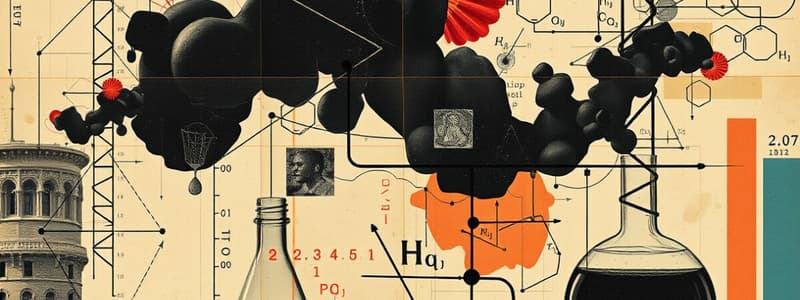Podcast
Questions and Answers
What are the parts of a chemical equation?
What are the parts of a chemical equation?
Reactants [left] and products [right]
What is equation stoichiometry?
What is equation stoichiometry?
The study of quantitative relationships between amounts of reactants used and products formed by a chemical change
What is formula stoichiometry?
What is formula stoichiometry?
The study of the quantitative relationships between elements in a chemical compound
What does synthesis refer to in chemistry?
What does synthesis refer to in chemistry?
What is decomposition in chemical reactions?
What is decomposition in chemical reactions?
What happens in a single replacement reaction?
What happens in a single replacement reaction?
What is a double replacement reaction?
What is a double replacement reaction?
What is combustion?
What is combustion?
What is stoichiometry?
What is stoichiometry?
What is percent yield?
What is percent yield?
What is a limiting reactant?
What is a limiting reactant?
What is an excess reactant?
What is an excess reactant?
Flashcards are hidden until you start studying
Study Notes
Chemical Equations
- Chemical equations consist of reactants on the left side and products on the right side.
Stoichiometry Types
- Equation Stoichiometry: Focuses on quantitative relationships between reactants and products involved in a chemical change.
- Formula Stoichiometry: Examines quantitative relationships among elements within a chemical compound.
Reaction Types
- Synthesis: Involves the combination of two or more substances to create a single compound; yields one product.
- Decomposition: A single compound breaks down into two or more simpler substances; involves only one reactant.
- Single Replacement: One element displaces another within a compound, involving either metal-for-metal or nonmetal-for-nonmetal replacement.
- Double Replacement: Involves an exchange of ions between two compounds, with cations swapping with anions.
- Combustion: The process of burning a substance in the presence of oxygen (O2), which typically results in carbon dioxide (CO2) and water (H2O) from hydrocarbons.
Key Concepts
- Stoichiometry: Similar to a recipe, it allows chemists to calculate relationships between reactants and products in chemical reactions.
- Percent Yield: Measures the efficiency of a reaction, comparing the actual amount of product obtained to the theoretical yield; calculated using the formula: % yield = (actual mass / theoretical mass) x 100.
- Limiting Reactant: Defined as the reactant that is completely consumed in a reaction, thus limiting the amount of product produced.
- Excess Reactant: Refers to any reactant that remains unreacted after the chemical reaction has completed.
Studying That Suits You
Use AI to generate personalized quizzes and flashcards to suit your learning preferences.




